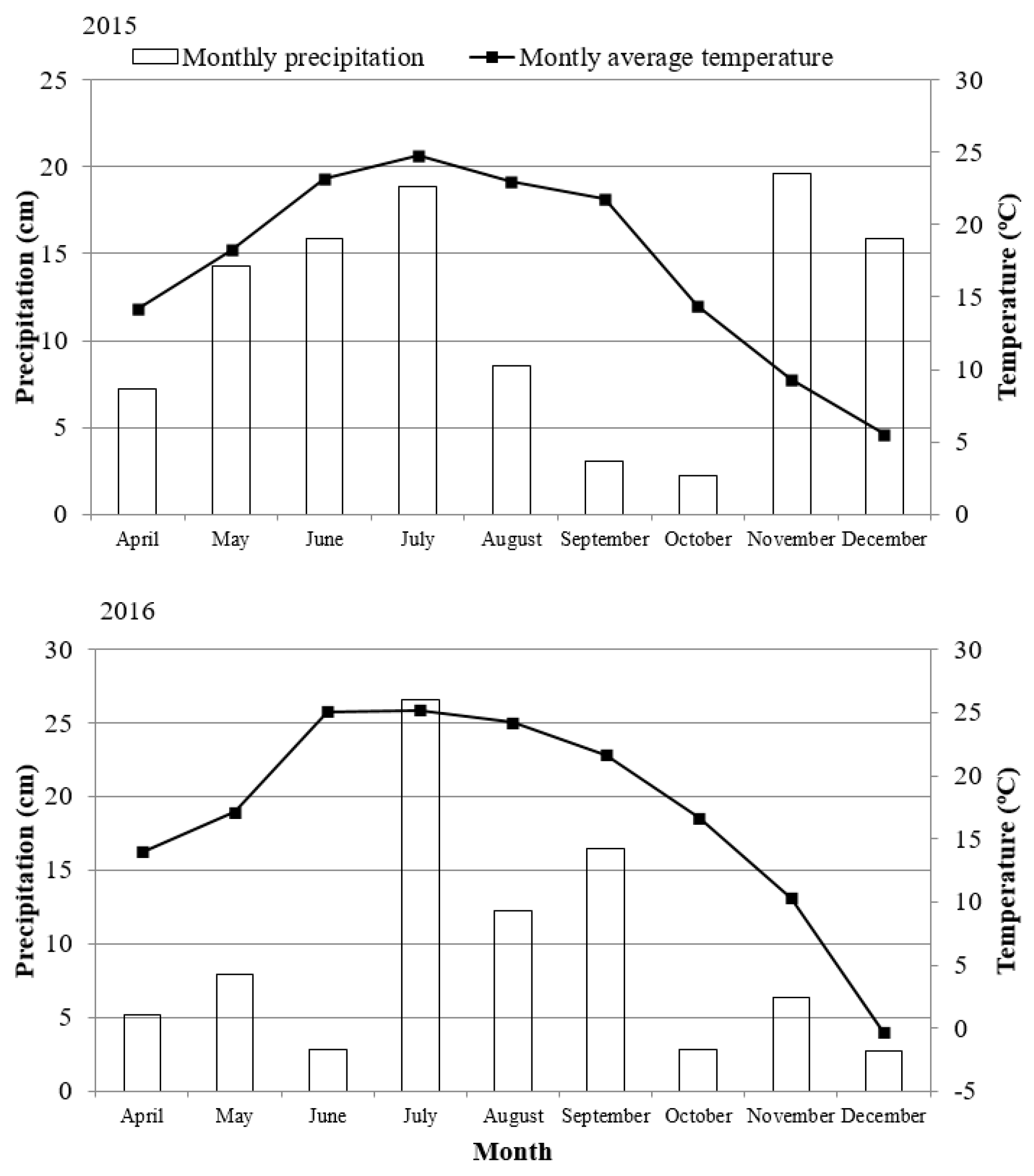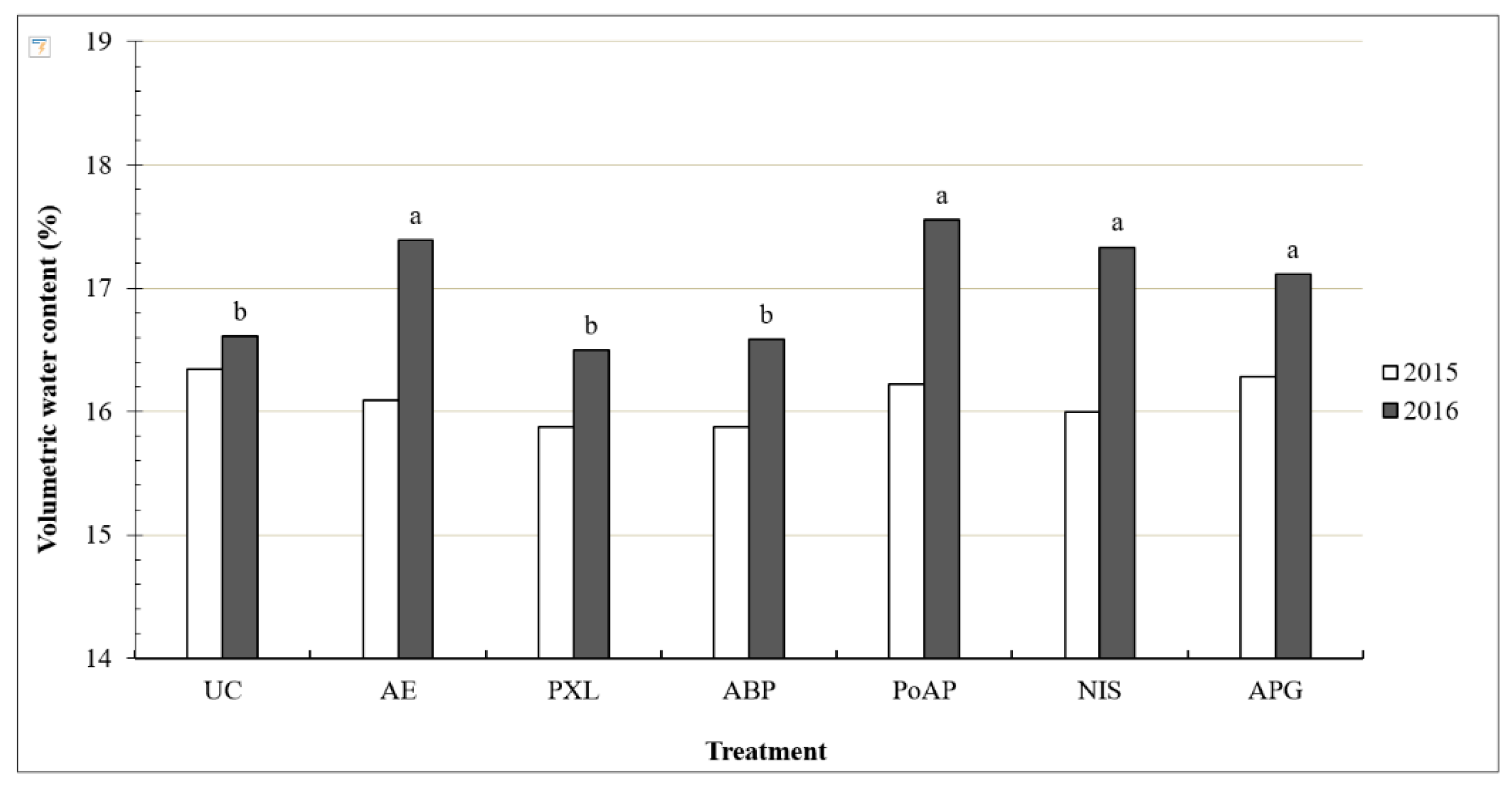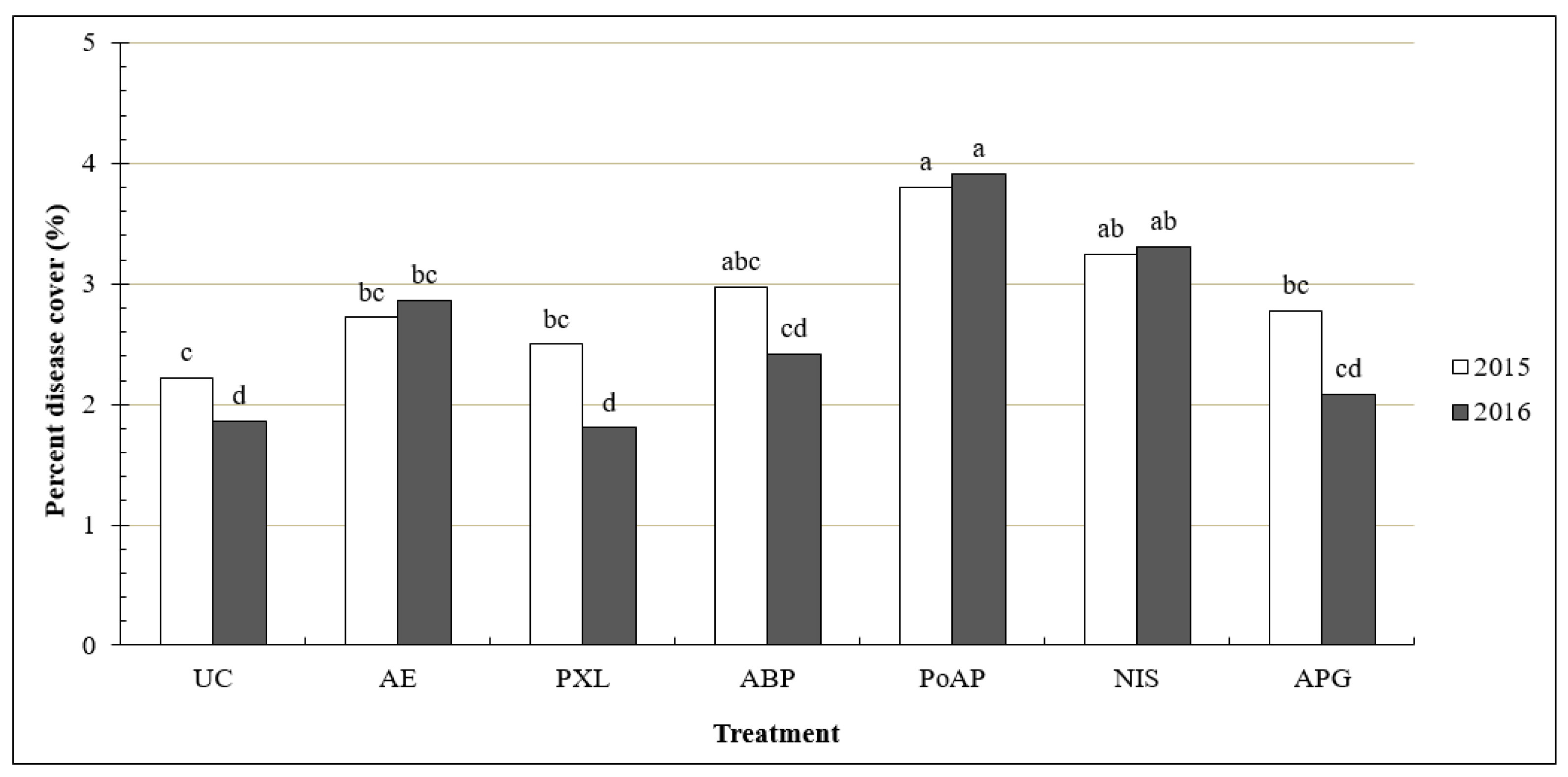Influence of Repeated Application of Wetting Agents on Soil Water Repellency and Microbial Community
Abstract
:1. Introduction
2. Materials and Methods
3. Results and Discussion
3.1. Weather Conditions
3.2. Soil VWC, LDS, and SWR
3.3. Disease and Turf Quality
3.4. Soil Microbial Diversity and Community
4. Conclusions
Author Contributions
Funding
Conflicts of Interest
References
- Karnok, K.J.; Tucker, K.A. The cause and control of localized dry spots on bentgrass greens. Golf Course Manag. 1989, 57, 28–34. [Google Scholar]
- Wilkinson, J.F.; Miller, R.H. Investigation and treatment of localized dry spots on sand golf greens. Agron. J. 1978, 70, 299–304. [Google Scholar] [CrossRef]
- Nektarios, P.A.; Steenhuis, T.S.; Petrovic, A.M. Fingered flow in laboratory golf putting greens. J. Turfgrass Sci. 1999, 3, 53–67. [Google Scholar]
- Wang, Z.; Wu, L.; Wu, Q.J. Water-entry value as an alternative indicator of soil water-repellency and wettability. J. Hydrol. 2000, 231, 76–83. [Google Scholar] [CrossRef]
- Larsbo, M.; Aamlid, T.S.; Persson, L.; Jarvis, N. Fungicide leaching from golf greens: Effects of root zone composition and surfactant use. J. Environ. Qual. 2008, 37, 1527–1535. [Google Scholar] [CrossRef] [PubMed]
- Roberts, F.J.; Carbon, B.A. Water repellence in sandy soils of Southwestern Australia. II. Some chemical characteristics of hydrophobic skins. Austral. J. Soil Res. 1972, 10, 35–42. [Google Scholar] [CrossRef]
- Doerr, S.H.; Shakesby, R.A.; Walsh, R.P.D. Soil water repellency: Its causes, characteristics and hydro-geomorphological significance. Earth Sci. Rev. 2000, 51, 33–65. [Google Scholar] [CrossRef]
- Kern, K.; David, R.; Palmer, R.L.; Comsa, G. Complete wetting on ‘strong’ substrates: Xe/Pt (111). Phys. Rev. Lett. 1986, 56, 2823–2927. [Google Scholar] [CrossRef]
- Tucker, K.A.; Karnok, K.J.; Radcliffe, D.E.; Landry, G.; Roncadori, R.W.; Tan, K.H. Localized dry spots as caused by hydrophobic sands on bentgrass greens. Agron. J. 1990, 82, 549–555. [Google Scholar] [CrossRef]
- Czarnes, S.; Hallett, P.D.; Bengough, A.G.; Young, I.M. Root- and microbial-derived mucilages affect soil structure and water transport. Eur. J. Soil Sci. 2000, 51, 435–443. [Google Scholar] [CrossRef]
- Feeney, D.S.; Hallett, P.D.; Rodger, S.; Bengough, A.G.; White, N.A.; Young, I.M. Impact of fungal and bacterial biocides on microbial induced water repellency in arable soil. Geoderma 2006, 135, 72–80. [Google Scholar] [CrossRef]
- Sun, Y.; Unestam, T.; Lucas, S.D.; Johanson, K.J.; Kenne, L.; Finlay, R. Exudation-reabsorption in a mycorrhizal fungus, the dynamic interface for interaction with soil and soil microorganisms. Mycorrhiza 1999, 9, 137–144. [Google Scholar] [CrossRef]
- Müller, K.; Deurer, M. Review of the remediation strategies for soil water repellency. Agric. Ecosyst. Environ. 2011, 144, 208–221. [Google Scholar] [CrossRef]
- Carrillo, M.L.K.; Letey, J.; Yates, S.R. Unstable Water Flow in a Layered Soil: I. Effects of a Stable Water-Repellent Layer. Soil Sci. Soc. Am. J. 2000, 64, 450–455. [Google Scholar] [CrossRef]
- Feng, G.L.; Letey, J.; Wu, L. Water ponding depths affect temporal infiltration rates in a water repellent sand. Soil Sci. Soc. Am. J. 2001, 65, 315–320. [Google Scholar] [CrossRef]
- Ritsema, C.J.; Dekker, L.W.; Hendrickx, J.M.H.; Hamminga, W. Preferential flow mechanism in a water repellent sandy soil. Water Resour. Res. 1993, 29, 2183–2193. [Google Scholar] [CrossRef]
- Song, E.; Schneider, J.G.; Anderson, S.H.; Goyne, W.K.; Xiong, X. Wetting agent influence on water infiltration into hydrophobic sand: II. Physical properties. Agron. J. 2014, 106, 1879–1885. [Google Scholar] [CrossRef]
- Karnok, K.J.; Tucker, K.A. Effects of flutolanil fungicide and primer wetting agent on water repellent soil. HortTech 2001, 11, 437–440. [Google Scholar] [CrossRef]
- U.S. Golf Association. USGA Recommendations for a Method of Putting Green Construction; USGA: Far Hills, NJ, USA, 2004; Available online: https://www.usga.org/content/dam/usga/images/course-care/2004%20USGA%20Recommendations%20For%20a%20Method%20of%20Putting%20Green%20Cons.pdf (accessed on 19 August 2019).
- King, P.M. Comparison of methods for measuring severity of water repellence of sandy soils and assessment of some factors that affect measurement. Aust. J. Soil Res. 1981, 19, 275–285. [Google Scholar] [CrossRef]
- Watson, C.L.; Letey, J. Indices for characterizing soil-water repellency based upon contact angle-surface tension relationships. Soil Sci. Soc. Am. Proc. 1970, 34, 841–844. [Google Scholar] [CrossRef]
- Buyer, J.S.; Sasser, M. High throughput phospholipid fatty acid analysis of soils. Appl. Soil Ecol. 2012, 61, 127–130. [Google Scholar] [CrossRef]
- Frostegård, A.; Tunlid, A.; Bååth, E. Phospholipid Fatty Acid composition, biomass, and activity of microbial communities from two soil types experimentally exposed to different heavy metals. Appl. Environ. Microb. 1993, 59, 3605–3617. [Google Scholar]
- Frostegård, A.; Bååth, E. The use of phospholipid fatty acid analysis to estimate bacterial and fungal biomass in soil. Biol. Fertil. Soils. 1996, 22, 59–65. [Google Scholar] [CrossRef]
- Unger, I.M.; Goyne, K.W.; Kremer, R.J.; Kennedy, A.C. Microbial community diversity in agroforestry and grass vegetative filter strips. Agrofor. Syst. 2013, 87, 395–402. [Google Scholar] [CrossRef]
- Olsson, P.A. Signature fatty acids provide tools for determination of the distribution and interactions of mycorrhizal fungi in soil. FEMS Microbiol. Ecol. 1999, 29, 303–310. [Google Scholar] [CrossRef]
- Buyer, J.S.; Teasdale, J.R.; Roberts, D.P.; Zasada, I.A.; Maul, J.E. Factors affecting soil microbial community structure in tomato cropping systems. Soil Biol. Biochem. 2010, 42, 831–841. [Google Scholar] [CrossRef]
- Song, E.; Schneider, J.G.; Anderson, S.H.; Goyne, W.K.; Xiong, X. Wetting agent influence on water infiltration into hydrophobic sand: I. Rewettability. Agron. J. 2014, 106, 1873–1878. [Google Scholar] [CrossRef]
- Song, E.; Goyne, K.W.; Kremer, R.J.; Anderson, S.H.; Xiong, X. Surfactant chemistry effects on organic matter removal from water repellent sand. Soil Sci. Soc. Am. J. 2018, 82, 1252–1258. [Google Scholar] [CrossRef]
- Pan, X.; Richardson, M.D.; Deng, S.; Kremer, R.J.; English, J.E.; Mihail, J.D.; Sams, C.E.; Scharf, P.C.; Veum, K.S.; Xiong, X. Effect of organic amendment and cultural practice on large patch occurrence and soil microbial community. Crop Sci. 2017, 57, 2263–2272. [Google Scholar] [CrossRef]
- Fierer, N.; Schimel, J.P.; Holden, P.A. Variations in microbial community composition through two soil depth profiles. Soil Biol. Biochem. 2003, 35, 167–176. [Google Scholar] [CrossRef]
- Couch, H.B.; Bloom, J.R. Influence of environment on diseases of turf-grasses. II. Influence of nutrition, pH and soil moisture on Sclerotinia dollar spot. Phytopathology 1960, 50, 761–763. [Google Scholar]
- McDonald, S.J.; Dernoedern, P.H.; Bigelow, C.A. Dollar spot and gray leaf spot severity as influenced by irrigation, chlorothalonil, paclobutrazol and a wetting agent. Crop Sci. 2006, 46, 2675–2684. [Google Scholar] [CrossRef]
- Ren, C.; Chen, J.; Lu, X.; Doughty, R.; Zhao, F.; Zhong, Z.; Han, X.; Yang, G.; Feng, Y.; Ren, G. Responses of soil total microbial biomass and community compositions to rainfall reductions. Soil Biol. Biochem. 2018, 116, 4–10. [Google Scholar] [CrossRef]
- Mikan, C.J.; Schimel, J.P.; Doyle, A.P. Temperature controls of microbial respiration in arctic tundra soils above and below freezing. Soil Biol. Biochem. 2002, 34, 1785–1795. [Google Scholar] [CrossRef]
- Herron, P.M.; Stark, J.M.; Holt, C.; Hooker, T.; Cardon, Z.G. Microbial growth efficiencies across a soil moisture gradient assessed using 13C-acetic acid vapor and 15N-ammonia gas. Soil Biol. Biochem. 2009, 41, 1262–1269. [Google Scholar] [CrossRef]
- Gougoulias, C.; Clark, J.M.; Shaw, L.J. The role of soil microbes in the global carbon cycle: Tracking the below-ground microbial processing of plant-derived carbon for manipulating carbon dynamics in agricultural systems. J. Sci. Food Agric. 2014, 94, 2362–2371. [Google Scholar] [CrossRef]
- Ogino, T.; Suzuki, T.; Sawada, K. The formation and transformation mechanism of calcium carbonate in water. Geochim. Cosmochim. Acta 1987, 51, 2757–2767. [Google Scholar] [CrossRef]
- Bhatti, A.A.; Haq, S.; Bhat, R.A. Actinomycetes benefaction role in soil and plant health. Microb. Pathog. 2017, 111, 458–467. [Google Scholar] [CrossRef]
- Roper, M.M. The isolation and characterization of bacteria with the potential to degrade waxes that cause water repellency in sandy soils. Aust. J. Soil Res. 2004, 42, 427–434. [Google Scholar] [CrossRef]
- Lang, S.; Philp, J.C. Surface-active lipids in rhodococci. Antonie Van Leeuwenhoek 1998, 74, 59–70. [Google Scholar] [CrossRef]
- Walter, U.; Beyer, M.; Klein, J.; Rehm, H.J. Degradation of pyrene by Rhodococcus sp. UW1. Appl. Microbiol. Biotechnol. 1991, 34, 671–676. [Google Scholar] [CrossRef]






| Treatment | Active Ingredient | Code | Rate (mL·L−1) |
|---|---|---|---|
| Untreated Control | -- | UC | -- |
| Cascade Plus | 10% alcohol ethoxylates and 90% polyethylene and polypropylene glycols. | AE | 62 |
| Hydro-Wet | 87.5% poloxanlene, 2-butoxyethanol. | PXL | 62 |
| Matador | 100% alkyl block polymer. | ABP | 47 |
| OARS | 80% polyoxyalkylene polymers and 10% potassium salt of alkyl substituted maleic acid. | PoAP | 27 |
| pHAcid | 100% blend of acidifying agents and a high molecular weight nonionic surfactant. | NIS | 250 |
| Tournament-Ready | 62% alkyl polyglycoside and siloxane solution, and 38% polyalkoxylate blend. | APG | 62 |
| Treatments † | 0MAIT | 1MAIT | 2MAIT | 3MAIT | 4MAIT | 5MAIT |
|---|---|---|---|---|---|---|
| --------------------------------------2015----------------------------------- | ||||||
| UC | 3.0 a2 ‡ | 3.1 b12 | 3.3 a1 | 3.4 a1 | 3.1 a1 | 3.3 a1 |
| AE | 2.9 a1 | 2.9 b1 | 2.9 cd1 | 2.9 cd1 | 2.3 d3 | 2.6 c2 |
| PXL | 3.0 a1 | 3.1 b1 | 3.0 bcd1 | 3.1 bc1 | 2.6 c2 | 2.9 b1 |
| ABP | 3.0 a1 | 3.1 b1 | 2.9 cd12 | 2.7 d23 | 2.4 d4 | 2.6 c34 |
| PoAP | 3.0 a12 | 3.1 b1 | 2.8 d23 | 3.0 cd12 | 2.3 d4 | 2.7 bc3 |
| NIS | 2.9 a3 | 3.4 a1 | 3.2 ab2 | 3.3 ab12 | 2.9 b3 | 3.1 ab23 |
| APG | 3.0 a12 | 3.1 b1 | 3.1 abc1 | 3.1 bc1 | 2.3 d3 | 2.7 bc2 |
| --------------------------------------2016----------------------------------- | ||||||
| UC | 2.6 a2 | 3.3 a1 | 3.2 a1 | 3.1 a1 | 3.0 a1 | 3.1 a1 |
| AE | 2.5 ab12 | 2.6 b1 | 2.4 d123 | 2.2 bc23 | 2.4 b123 | 2.1 bc3 |
| PXL | 2.4 ab12 | 2.5 b12 | 2.6 cd1 | 2.3 bc2 | 2.2 b23 | 2.0 c3 |
| ABP | 2.5 ab12 | 2.7 b1 | 2.5 cd1 | 2.1 c3 | 2.5 b12 | 2.2 bc23 |
| PoAP | 2.3 b2 | 2.6 b1 | 2.7 bc1 | 2.3 bc2 | 2.3 b2 | 2.1 bc2 |
| NIS | 2.5 ab2 | 3.1 a1 | 3.0 ab1 | 2.9 a1 | 3.0 a1 | 3.0 a1 |
| APG | 2.4 ab1 | 2.5 b1 | 2.6 cd1 | 2.4 b1 | 2.5 b1 | 2.4 b1 |
| Treatments ‡ | October 2015 | May 2016 | October 2016 |
|---|---|---|---|
| --------------------Aerobic bacteria (nmol·g−1)-------------------- | |||
| UC | 15.3 a2 § | 17.2 a2 | 19.3 b1 |
| AE | 15.3 a2 | 16.6 ab12 | 19.0 b1 |
| PXL | 14.6 a2 | 15.3 ab2 | 19.6 b1 |
| ABP | 14.8 a2 | 14.3 b2 | 18.9 b1 |
| PoAP | 14.1 a2 | 16.3 ab12 | 18.6 b1 |
| NIS | 15.5 a2 | 15.4 ab2 | 23.1 a1 |
| APG | 13.8 a2 | 17.8 a1 | 17.3 b1 |
| --------------------Anaerobic bacteria (nmol·g−1)-------------------- | |||
| UC | 7.9 a2 | 8.0 a2 | 9.5 b1 |
| AE | 8.0 a12 | 7.4 ab2 | 8.8 b1 |
| PXL | 7.8 a2 | 7.2 ab2 | 9.0 b1 |
| ABP | 7.4 a2 | 6.7 b2 | 8.8 b1 |
| PoAP | 7.6 a2 | 7.6 ab2 | 8.7 b1 |
| NIS | 8.1 a2 | 6.9 b3 | 10.5 a1 |
| APG | 7.4 a2 | 8.0 a2 | 8.5 b1 |
| --------------------Actinomycetes (nmol·g−1)-------------------- | |||
| UC | 6.1 a2 | 5.5 a2 | 8.1 b1 |
| AE | 6.3 a2 | 5.2 a3 | 7.7 b1 |
| PXL | 6.0 a2 | 4.9 a3 | 7.6 b1 |
| ABP | 5.9 a2 | 4.8 a3 | 7.5 b1 |
| PoAP | 5.9 a2 | 5.4 a2 | 7.4 b1 |
| NIS | 6.4 a2 | 4.8 a3 | 9.0 a1 |
| APG | 5.8 a2 | 5.5 a2 | 7.3 b1 |
| ----------------Arbuscular mycorrhizae (nmol·g−1)---------------- | |||
| UC | 4.7 a2 | 5.4 a2 | 7.0 bc1 |
| AE | 4.6 a2 | 4.8 ab2 | 6.5 bc1 |
| PXL | 4.4 a2 | 4.6 ab2 | 7.0 b1 |
| ABP | 4.3 a2 | 4.3 b2 | 7.1 b1 |
| PoAP | 4.3 a2 | 4.9 ab2 | 6.7 bc1 |
| NIS | 4.9 a2 | 4.6 ab2 | 8.4 a1 |
| APG | 4.2 a3 | 5.2 a2 | 6.2 c1 |
| --------------------Mycorrhizae (nmol·g−1)-------------------- | |||
| UC | 6.6 a2 | 7.1 a2 | 10.3 bc1 |
| AE | 6.3 a2 | 6.4 ab2 | 9.7 bc1 |
| PXL | 6.1 a2 | 6.2 ab2 | 10.6 b1 |
| ABP | 6.0 a2 | 5.7 b2 | 10.8 b1 |
| PoAP | 6.1 a2 | 6.6 ab2 | 10.2 bc1 |
| NIS | 6.7 a2 | 6.1 ab2 | 12.6 a1 |
| APG | 5.9 a2 | 6.8 ab2 | 9.2 c1 |
| --------------------Bacteria (nmol·g−1)-------------------- | |||
| UC | 34.0 a2 | 34.9 ab2 | 41.4 b1 |
| AE | 34.0 a2 | 32.9 abc21 | 39.7 b1 |
| PXL | 32.6 a2 | 31.0 abc2 | 40.7 b1 |
| ABP | 32.2 a2 | 28.9 c2 | 40.1 b1 |
| PoAP | 31.8 a2 | 33.2 abc2 | 39.0 b1 |
| NIS | 35.2 a2 | 30.6 bc2 | 48.0 a1 |
| APG | 31.1 a2 | 35.3 a12 | 37.1 b1 |
| --------------------Total PLFA (nmol·g−1)-------------------- | |||
| UC | 81.8 a2 | 87.6 a2 | 111.4 b1 |
| AE | 80.8 a2 | 82.9 ab21 | 106.9 b1 |
| PXL | 77.3 a2 | 78.8 ab2 | 108.4 b1 |
| ABP | 84.6 a2 | 73.4 b2 | 108.2 b1 |
| PoAP | 76.4 a2 | 84.5 ab2 | 105.6 b1 |
| NIS | 83.4 a2 | 77.6 ab2 | 128.3 a1 |
| APG | 74.2 a2 | 88.4 a1 | 99.6 b1 |
© 2019 by the authors. Licensee MDPI, Basel, Switzerland. This article is an open access article distributed under the terms and conditions of the Creative Commons Attribution (CC BY) license (http://creativecommons.org/licenses/by/4.0/).
Share and Cite
Song, E.; Pan, X.; Kremer, R.J.; Goyne, K.W.; Anderson, S.H.; Xiong, X. Influence of Repeated Application of Wetting Agents on Soil Water Repellency and Microbial Community. Sustainability 2019, 11, 4505. https://doi.org/10.3390/su11164505
Song E, Pan X, Kremer RJ, Goyne KW, Anderson SH, Xiong X. Influence of Repeated Application of Wetting Agents on Soil Water Repellency and Microbial Community. Sustainability. 2019; 11(16):4505. https://doi.org/10.3390/su11164505
Chicago/Turabian StyleSong, Enzhan, Xiaowei Pan, Robert J. Kremer, Keith W. Goyne, Stephen H. Anderson, and Xi Xiong. 2019. "Influence of Repeated Application of Wetting Agents on Soil Water Repellency and Microbial Community" Sustainability 11, no. 16: 4505. https://doi.org/10.3390/su11164505
APA StyleSong, E., Pan, X., Kremer, R. J., Goyne, K. W., Anderson, S. H., & Xiong, X. (2019). Influence of Repeated Application of Wetting Agents on Soil Water Repellency and Microbial Community. Sustainability, 11(16), 4505. https://doi.org/10.3390/su11164505





